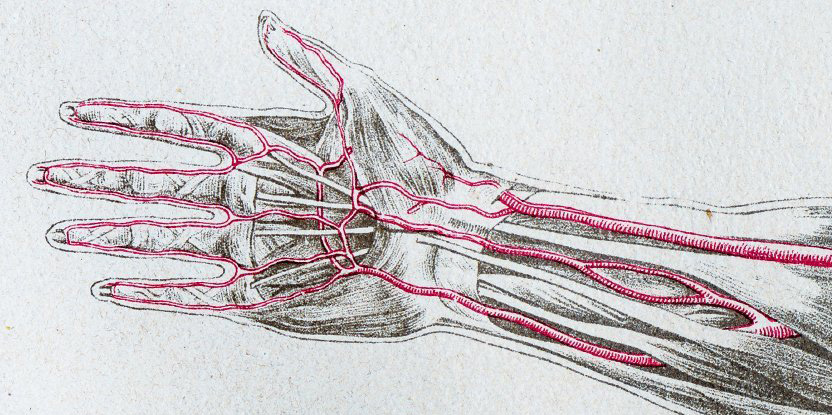
Posted on 10/09/2020 11:03:16 AM PDT by Red Badger

Picturing how our species might appear in the far future often invites wild speculation over stand-out features such as height, brain size, and skin complexion. Yet subtle shifts in our anatomy today demonstrate how unpredictable evolution can be.
Take something as mundane as an extra blood vessel in our arms, which going by current trends could be common place within just a few generations.
Researchers from Flinders University and the University of Adelaide in Australia have noticed an artery that temporarily runs down the centre of our forearms while we're still in the womb isn't vanishing as often as it used to.
That means there are more adults than ever running around with what amounts to be an extra channel of vascular tissue flowing under their wrist.
"Since the 18th century, anatomists have been studying the prevalence of this artery in adults and our study shows it's clearly increasing," says Flinders University anatomist Teghan Lucas.
"The prevalence was around 10 percent in people born in the mid-1880s compared to 30 percent in those born in the late 20th century, so that's a significant increase in a fairly short period of time, when it comes to evolution."
The median artery forms fairly early in development in all humans, transporting blood down the centre of our arms to feed our growing hands.

Three major arteries in the forearm - median in the centre
At around 8 weeks, it usually regresses, leaving the task to two other vessels – the radial (which we can feel when we take a person's pulse) and the ulnar arteries.
Anatomists have known for some time that this withering away of the median artery isn't a guarantee. In some cases, it hangs around for another month or so.
Sometimes we're born with it still pumping away, feeding either just the forearm, or in some cases the hand as well.
To compare the prevalence of this persistent blood channel, Lucas and colleagues Maciej Henneberg and Jaliya Kumaratilake from the University of Adelaide examined 80 limbs from cadavers, all donated by Australians of European descent.
The donors raged from 51 to 101 on passing, which means they were nearly all born in the first half of the 20th century.
Noting down how often they found a chunky median artery capable of carrying a good supply of blood, they compared the figures with records dug out of a literature search, taking into account tallies that could over-represent the vessel's appearance.
The fact the artery seems to be three times as common in adults today as it was more than a century ago is a startling find that suggests natural selection is favouring those who hold onto this extra bit of bloody supply.
"This increase could have resulted from mutations of genes involved in median artery development or health problems in mothers during pregnancy, or both actually," says Lucas.
We might imagine having a persistent median artery could give dextrous fingers or strong forearms a dependable boost of blood long after we're born. Yet having one also puts us at a greater risk of carpal tunnel syndrome, an uncomfortable condition that makes us less able to use our hands.
Nailing down the kinds of factors that play a major role in the processes selecting for a persistent median artery will require a lot more sleuthing.
Whatever they might be, it's likely we'll continue to see more of these vessels in coming years.
"If this trend continues, a majority of people will have median artery of the forearm by 2100," says Lucas.
This rapid rise of the median artery in adults isn't unlike the reappearance of a knee bone called the fabella, which is also three times more common today than it was a century ago.
As small as these differences are, tiny microevolutionary changes add up to large-scale variations that come to define a species.
Together they create new pressures themselves, putting us on new paths of health and disease that right now we might find hard to imagine today.
This research was published in the Journal of Anatomy.
Micro evolution is demonstrable. Always has been.
Macro evolution doesn’t exist, and has never existed. That is the problem with Chuck Darwin and his adherents.
We're also taller than we used to be. Still human.
Darwinism hasn’t quite reached it’s end goal yet, one can only surmise.
Would you consider this a mutation that’s just been able to sustain itself over generations?
“Darwinism” has no “end goal”.
the extra use of our thumbs in playing nintendo has driven the need for more blood flow to the digits.
Not enough generations for natural selection to create this change. I’ve always thought that brains and genes can create changes on their own to meet various needs. That goes beyond normal natural selection as alterations can occur far sooner. Seen such in very rapid changes in nature, that defy the timeline that pure natural selection could account for. So, in essence, I think there is intelligence involved in evolution.
Reptilian DNA
Shows the degenerating DNA baseline, the extra artery should be go e, but that part of the code is weak. Extra arteries is not really a good thing as it is a serious failure point if cut. Its purpose is to increase the blood flow when the hand is forming and is un necessary once 5hat is comete
A third eye in the forehead is also of dubious value. But one on the back of the head could be of use. Arguing the forehead eye as evolution is the same, though most would call it a horrible deformity.
Wonder how long this “observation” of the median artery has been going on for. How do they know who loses it and who keeps it, never mind who “regenerates” it?
If God wants us to have the median artery to keep going for whatever reason, He does it. There is no “microevolution”, if that word even has a true definition.
Democrats are proof of Devolution.....and that’s NOT “progress”.




ALL LIFE adapts faster than the “world is coming to an end” scare mongers today claim it does.
This is a genetic mutation not ‘evolution’ but labeled as such to get everyone’s dander up.
Depends on which of the many competing theories of “evolution” a person decides to have faith in:
“For those who dream of a better life, science has bad news: this is the best it is going to get. Our species has reached its biological pinnacle and is no longer capable of changing.
That is the stark, controversial view of a group of biologists who believe a Western lifestyle now protects humanity from the forces that used to shape Homo sapiens.
‘If you want to know what Utopia is like, just look around - this is it,’ said Professor Steve Jones”
I go with the Ancient Alien Theory Of Evolution, myself. Not because it has any more validity than the other theories fighting it out in their misc Darwinism denominations - just that it’s the coolest & most fun of the stories Darwinists have come up with
This would be a way to explain the amount of change that is surmised to have occurred over the four billion years of Earth's existence... even though most mathematical models would suggest that even four billion years is not enough time for random chance and natural selection.
Disclaimer: Opinions posted on Free Republic are those of the individual posters and do not necessarily represent the opinion of Free Republic or its management. All materials posted herein are protected by copyright law and the exemption for fair use of copyrighted works.